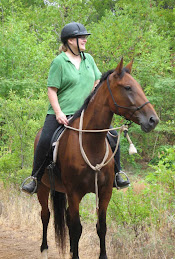
We lost Trudy on Thursday, Nov. 12. She was beautiful a 12-year-old roan Appaloosa, the first horse of my dear friend Kathy. Trudy was a friendly, personality-plus equine, but she was also very competitive, like her owner. On a regular basis, Trudy and Kathy participated in – and won - a number of timed play-day activities that required speed and skill. Trudy was six years old when she fractured her leg while practicing pole bending. The accident occurred just two weeks before Trudy and Kathy were scheduled to compete in pole-bending and barrel racing events at the Appaloosa World Show.
Kathy heard the “popping sound” and immediately pulled Trudy to a stop; Trudy didn’t move and wouldn’t put any weight on her right front leg. She had suffered a length-wise fracture in the upper pastern bone, but there was no breaking of the skin and no follow-up infections. Her lower leg was set in a cast for several months, and fortunately, she didn’t develop fatal complications like the high-profile racehorse Barbaro did in 2007. Trudy ended up with slightly crooked leg, but she rehabilitated well and would snort and canter in the pasture like nothing was wrong. But she couldn’t be ridden any more.
In February 2006, Trudy had her first and only foal, a feisty bay baby with a white star on her forehead and a smattering of white spots on her rump. Kathy named the filly Sparkles (registered name: BrightSparkingFireball) and worked with her constantly to ensure good ground manners before she moved to her new home in Los Cerritos, near Los Angeles. Trudy was a good mom and very protective of Sparkles. But the weight gain during pregnancy wasn’t good for Trudy’s bad leg, and Kathy knew she could not have another foal.
Trudy went to live in a pasture with other horses in Krum, Texas, but recently, the owner of the property called to say Trudy was having some problems “eliminating.” As it turned out, Trudy had acquired an extremely rare disease called cauda equina neuritis. Basically, the disease paralyses the horse’s insides from the mid-section on down, and the horse can’t pee or poop. The vet said that in 27 years of practice Trudy’s was only the third case she’d seen. No one knows how horses get it or how to cure it. It is impossible to manage, and if ignored, it will lead to a painful death. The vet said the most humane thing would be to put Trudy down.
Ann, another of our riding buddies, and I spent some time with Kathy the morning of Nov. 12. I took about 50 photos of Kathy with Trudy. The picture on this page is one of them, and I PhotoShopped the furrowed brow off Kathy's face. What was so difficult was how beautiful and healthy the horse appeared. The disease was not causing her any problems that day, and she was cheerfully eating grass and carrots and checking bystanders for possible treats. An appointment to put her down was set for 4 p.m.
I was with both my cancer-stricken dogs when they were put down, a procedure that took probably two minutes and was strangely peaceful after the pain they had suffered. Putting down a horse is much more involved. Trudy first received a mild sedative and then two large injections of a Pepto-Bismol pink barbiturate-type liquid. Slowly, she sunk down to the ground, but she experienced labored breathing for almost 10 minutes until the vet administered a third dose. Trudy had already survived a broken leg, and she was a tough fighter till the end.
There is no way to make losing a pet (dog, cat, horse, parakeet or even an iguana, I suppose) less painful or traumatic. Later that evening Kathy and I met for Texas comfort food (margaritas and nachos). But our only real comfort was the knowledge that Trudy had a good, if too-short life, and was loved and cared for properly the entire time. Every horse should be as lucky as Trudy was.





